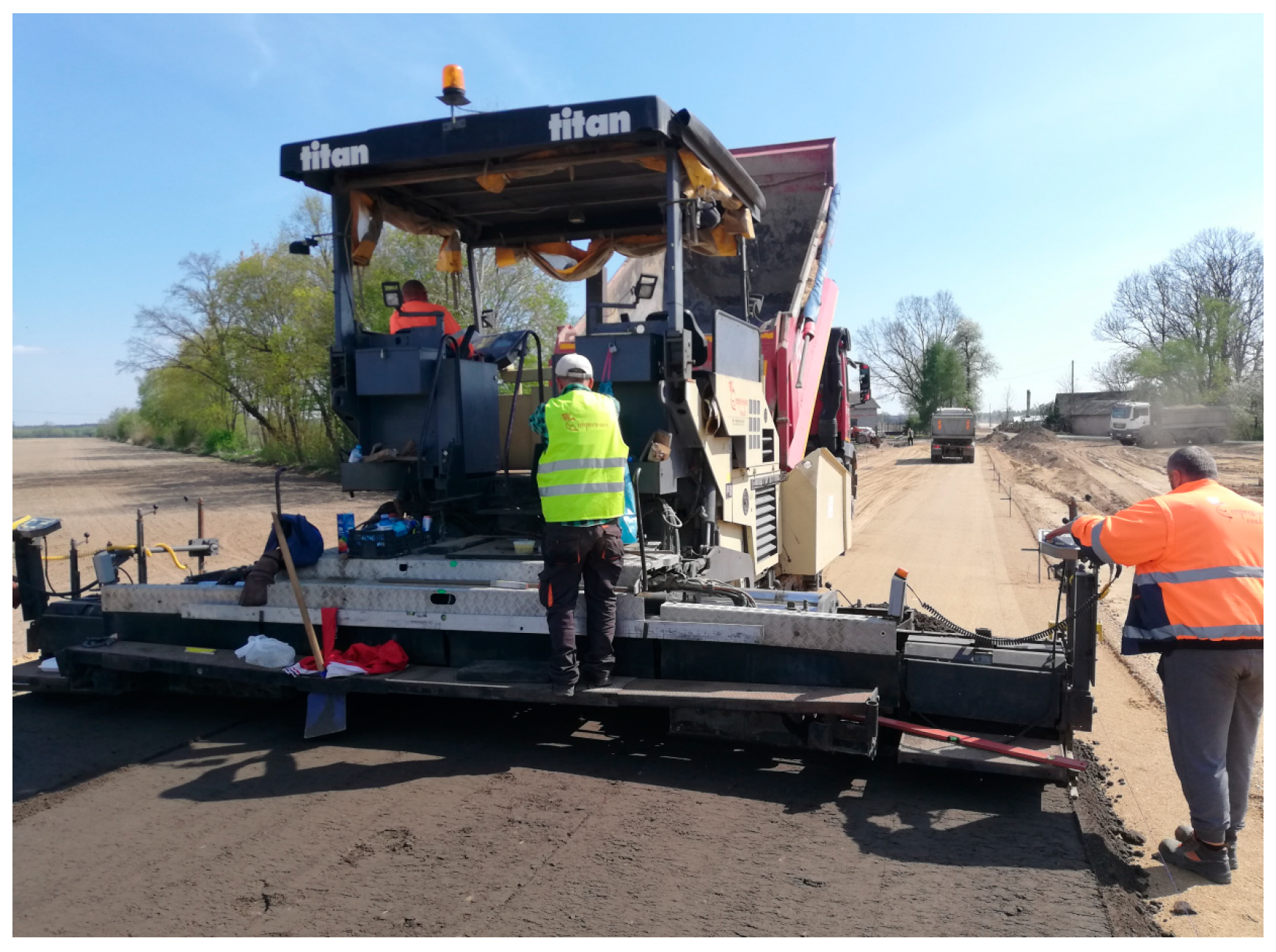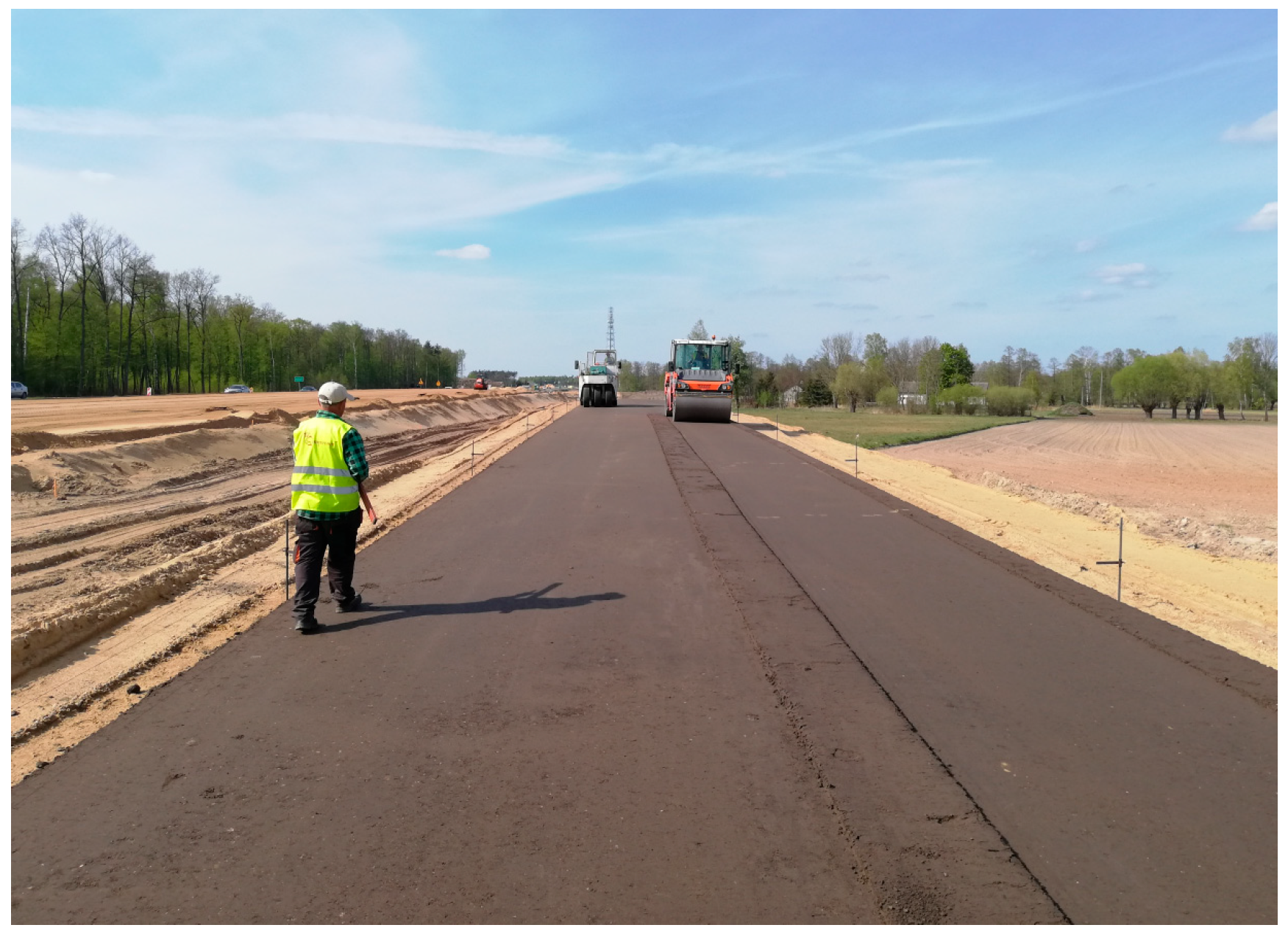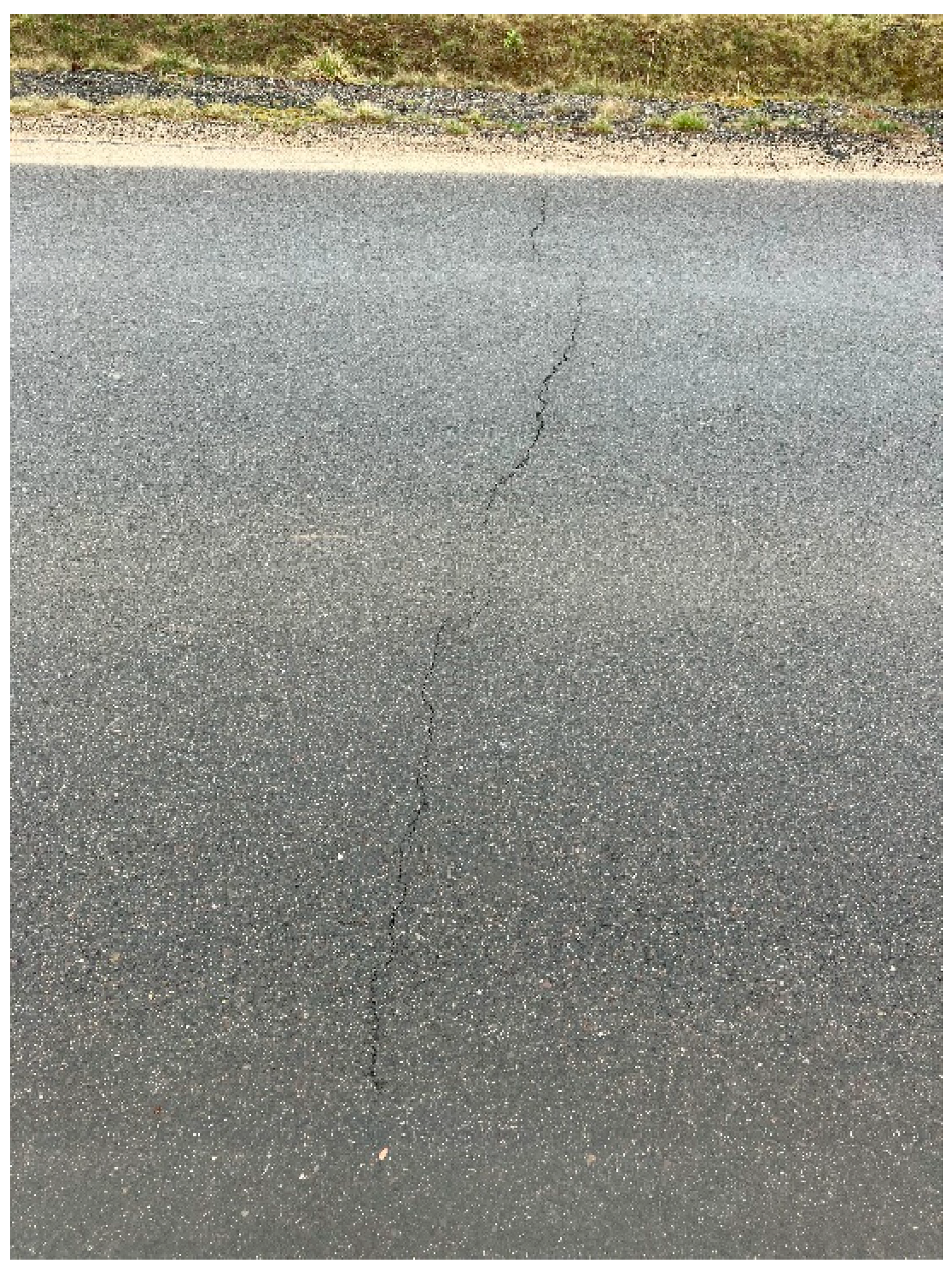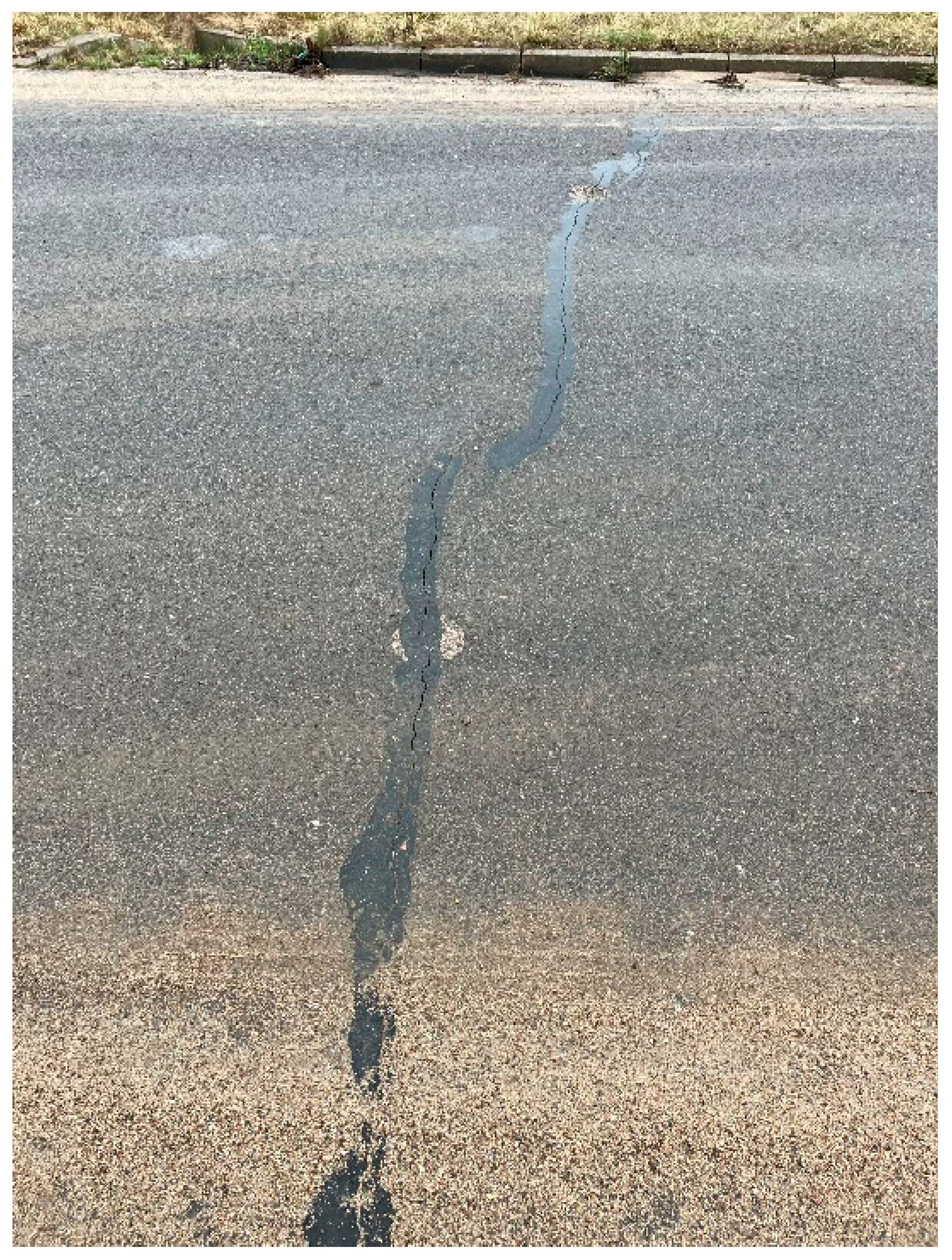Experimental and Field Assessment of Mineral–Cement–Emulsion Mixtures Containing Recycled Components
Abstract
1. Introduction
1.1. Specificity of Mineral–Cement–Emulsion Mixtures
1.2. Advantages and Disadvantages of Using Mineral–Cement–Emulsion Mixtures
- Reduced consumption of natural resources without compromising the parameters of the mixture produced;
- Reduced costs of road development projects;
- A relatively simple production technology;
- ‘Cold-mixing’ technology means limiting the energy required to produce the mixture and reducing the carbon footprint.
- Because such mixtures as a material present diverse and complex rheological, mechanical, and fatigue properties, they are placed between elastic and viscoelastic materials;
- The properties of the mixtures are strongly dependent on the quantity of binding agents they contain;
- Studies yield different results because of the content of heterogeneous materials such as reclaimed asphalt, e.g., from an old road surface; hence, the use of any materials from demolition requires careful selection and processing so as to ensure the cohesion and good quality of an MCE mixture;
- There is a general tendency to minimize the content of cement in MCE mixtures. Frequently, the standards set the maximum cement content at 1–2%, where a higher cement content would be acceptable. Creating an MCE mixture in which bituminous binding dominates hydraulic binding is still an unsolved problem.
1.3. Opportunities and Barriers to the Development of Technology Using Recycled Raw Materials
- Variability in the quality of recycled materials, especially of reclaimed asphalt pavement and concrete aggregates, which may contain contaminants (e.g., gypsum, wood, thermally cracked asphalt). Such raw materials need detailed laboratory analysis and sorting [48].
- Problems with the consistency of the mixture: the recycling of heterogeneous materials can result in the occurrence of weak points in the structural layers of a road [49,50]. There is a lack of consistent design guidelines in many countries, and there are no uniform technological standards or procedures for designing road surfaces with MCE mixtures. There are differences at every stage of the design process, including the selection of materials and the evaluation of the mixture produced [18,19,20].
- Possibilities for implementing MCE technology on smaller development projects carried out by local authorities can be limited by the lack of proper equipment or infrastructure as well as insufficient knowledge and experience, which can also be a barrier to construction companies lacking adequate resources.
- Lower frost resistance and higher water absorbability: mixtures containing reclaimed aggregate in their composition may be prone to higher water absorption and be structurally weaker to repeated freeze–thaw cycles [25].
2. Materials and Methods
- To perform a comprehensive laboratory evaluation of MCE mixtures, determining indirect tensile strength (ITS), stiffness modulus (IT-CY), bulk density, and air-void content based on approximately 160 individual tests.
- To conduct field observations on a trial road section, assessing compaction quality, surface condition, and the occurrence of transverse cracking during the first year of service.
- To provide a mechanistic interpretation of the observed field behavior, identifying the main factors contributing to cracking despite compliance with technical specifications.
- To propose practical recommendations for optimizing binder composition and curing procedures to improve the long-term performance of MCE mixtures with recycled components.
2.1. Composition of the MCE Mixture Used
2.2. MCE Layer Construction Technology
- Whether the equipment for laying and compacting the aggregate was adequate;
- The thickness of a loose layer of material necessary to obtain the set thickness of the compacted layer;
- The number of roller passes necessary to achieve the required compactness and bearing capacity;
- The usefulness of the proposed recipe for making the substructure layer with the MCE mixture;
- The usefulness of the equipment and the choice of means of transport to deliver the mixture;
- The homogeneity of the MCE mixture layer and the efficiency of the compaction equipment;
- The parameters of the layer made of the MCE mixture.
- After 7 days: E2 > 130 MPa (EVD ≥ 65 MPa);
- After 28 days: E2 > 180 MPa (EVD ≥ 90 MPa);
- Compaction index: Is ≥ 098.
- Quality of the mineral mixture—visual assessment;
- Approximate content of grading materials;
- Dosing of binders (cement and asphalt emulsion);
- Homogeneity and surroundings—visual assessment;
- Thickness of the layer after compaction;
- Width and the transverse inclination of the layer;
- Wet particle size distribution (grading) of the mixture of aggregate with reclaimed asphalt, according to the standard PN-EN 933-1 [62], tested once daily;
- Moisture content of the mixture according to PN-EN 1097-5 [63], should correspond to ±20% of mopt tested once daily;
- Content of asphalt in the reclaimed asphalt emulsion based on extraction according to PN-EN 12697-1: tested once daily;
- Content of cement in the mixture, according to the manufacturer’s documents: constant control;
- Content of emulsion in the mixture: constant control;
- Properties of cement: in case of doubt;
- Properties of emulsions: in case of doubt;
- Properties of water: in case of a dubious source of water.
3. Results
- Void content—once (three samples) per 3000 m2;
- Intermediate tensile strength ITS after 28 days—once (three samples) per 3000 m2;
- Stiffness modulus IT-CY after 28 days—once (three samples) per 6000 m2;
- Bearing capacity of the subbase layer; deformation modulus E2 or dynamic modulus EVD after 7 days or after 28 days if possible, twice per layer;
- Thickness of the layers: three points on a daily plot (min. 1/2000 m2);
- Compaction index: once per 3000 m2;
- Checking geometric features.
- Positive quality parameters of the layer were obtained—meeting the ST requirements with respect to compaction and load-bearing capacity;
- Positive intermediate tensile strength after 28 days was obtained;
- Positive resistance of the samples to water was obtained;
- The proper stiffness modulus IT-CY was obtained;
- On the basis of the evenness control results, it was determined that the building equipment for spreading and compacting the mixture was suitable and ensured the construction of a homogenous and smooth surface;
- The layer’s thickness control (after compaction) enabled determination of the minimum thickness (+4.0 cm relative to the designed thickness) needed to obtain the required thickness of 0.20 m of the finished layer after compaction;
- The layer’s compaction control enabled determination of the number of passes of each type of a roller ensuring the achievement of the required compaction index. The above number was determined as four passes with a heavy steel wheeled roller in order to compact the deep subbase and four passes with a pneumatic tired roller in order to seal the surface of the layer.
4. Discussion
- (1)
- The hydration shrinkage of cement, which leads to internal tensile stresses during early curing stages;
- (2)
- The thermal contraction of the rigid MCE layer during temperature drops, which is not fully compensated for by the viscoelastic relaxation of the asphalt emulsion;
- (3)
- The stiffness mismatch between the MCE base and the flexible asphalt overlay, which promotes stress concentration at the interface.
5. Conclusions
Author Contributions
Funding
Data Availability Statement
Conflicts of Interest
References
- Szafranko, E.; Harasymiuk, J.; Jurczak, M. Circular economy in construction as an element of the green building philosophy. Proc. Int. Multidiscip. Sci. Geoconf. 2024, 6, 171–178. [Google Scholar]
- Szafranko, E. Circular economy implemented on the construction site. Constr. Optim. Energy Potential/Bud. O Zoptymalizowanym Potencjale Energetycznym 2025, 14, 46–54. [Google Scholar] [CrossRef]
- Dołżycki, B.; Jaskuła, P. Review and evaluation of cold recycling with bitumen emulsion and cement for rehabilitation of old pavements. J. Traffic Transp. Eng. 2019, 6, 311–323. [Google Scholar] [CrossRef]
- Chomicz-Kowalska, A.; Stępień, J. Cost and eco-effective cold in-place recycled mixtures with foamed bitumen during the reconstruction of a road section under variable load bearing capacity of the subgrade. Procedia Eng. 2016, 161, 980–989. [Google Scholar] [CrossRef][Green Version]
- Firlej, S.; Kukiełka, J. Load bearing capacity of a nationalroad with base course made of mineral-cement-emulsion mixture after 12 years of exploitation. Roads Bridges—Drog. I Mosty 2019, 18, 3. [Google Scholar][Green Version]
- Pasetto, M.; Baldo, N. Cold recycled mixes with cement and bitumen emulsion for sustainable pavements: Mechanical and environmental assessment. Mater. Struct. 2011, 44, 1197–1211. [Google Scholar][Green Version]
- Skotnicki, Ł.; Kuźniewski, J.; Szydło, A. Research on the properties of mineral–cement emulsion mixtures using recycled road pavement materials. Materials 2021, 14, 563. [Google Scholar] [CrossRef]
- Mazurek, G.; Iwanski, M. Optimisation of the innovative hydraulic binder composition for its versatile use in recycled road base layer. IOP Conf. Ser. Mater. Sci. Eng. 2019, 603, 032044. [Google Scholar] [CrossRef]
- Yang, W.; Ouyang, J.; Meng, Y.; Han, B.; Sha, Y. Effect of curing and compaction on volumetric and mechanical properties of cold-recycled mixture with asphalt emulsion under different cement contents. Constr. Build. Mater. 2021, 297, 123699. [Google Scholar] [CrossRef]
- Miljković, M.; Poulikakos, L.; Piemontese, F.; Shakoorioskooie, M.; Lura, P. Mechanical behaviour of bitumen emulsion-cement composites across the structural transition of the co-binder system. Constr. Build. Mater. 2019, 215, 217–232. [Google Scholar] [CrossRef]
- Chen, T.; Luan, Y.; Ma, T.; Zhu, J.; Huang, X.; Ma, S. Mechanical and microstructural characteristics of different interfaces in cold recycled mixture containing cement and asphalt emulsion. J. Clean. Prod. 2020, 258, 120674. [Google Scholar] [CrossRef]
- Cui, K.; Chang, J. Hydration, reinforcing mechanism, and macro performance of multi-layer graphene modified cement composites. J. Build. Eng. 2022, 57, 104880. [Google Scholar] [CrossRef]
- Lu, D.; Jiang, X.; Zhifei, T.; Binbin, Y.; Zhen, L.; Jing, Z. Enhancing sustainability in pavement Engineering: A-state-of-the-art review of cement asphalt emulsion mixtures. Clean. Mater. 2023, 9, 100204. [Google Scholar] [CrossRef]
- Jain, S.; Singh, B. Cold mix asphalt: An overview. J. Clean. Prod. 2021, 280, 124378. [Google Scholar] [CrossRef]
- Lin, J.; Hong, J.; Xiao, Y. Dynamic characteristics of 100% cold recycled asphalt mixture using asphalt emulsion and cement. J. Clean. Prod. 2017, 156, 337–344. [Google Scholar] [CrossRef]
- Su, N.; Xiao, F.; Wang, J.; Amirkhanian, S. Characterizations of base and subbase layers for Mechanistic-Empirical Pavement Design. Constr. Build. Mater. 2017, 152, 731–745. [Google Scholar] [CrossRef]
- Iowa State University Institute for Transportation. Pavement Subbase Design and Construction; SUDAS Design Manual, Section 6F-1; Iowa State University Institute for Transportation: Ames, IA, USA, 2020. [Google Scholar]
- Liu, L.; Li, Z.; Cai, G.; Liu, X.; Yan, S. Humidity field characteristics in road embankment constructed with recycled construction wastes. J. Clean. Prod. 2020, 259, 120977. [Google Scholar] [CrossRef]
- Asphalt Emulsion Manufacturers Association; Asphalt Institute; Federal Highway Administration. Basic Asphalt Emulsion Manual, 6th ed.; Asphalt Recycling & Reclaiming Association: Glen Ellyn, IL, USA, 2019. [Google Scholar]
- Asphalt Recycling & Reclaiming Association (ARRA). Basic Asphalt Recycling Manual, 2nd ed.; Asphalt Recycling & Reclaiming Association: Glen Ellyn, IL, USA, 2015. [Google Scholar]
- Tao, M.A.; Lu, Y.-C.; He, L.; Huang, X.-M.; Wang, S.-Q.; Wang, N.; Yuan, M.A. Review on cold recycling technology development of emulsified asphalt and foamed asphalt. J. Transp. Eng. 2023, 23, 1–23. [Google Scholar]
- Zhao, H.; Su, J.; Ma, S.; Su, C.; Wang, X.; Li, Z.; Wei, J.; Cui, S. Study on cold recycled asphalt mixtures with emulsified/foamed asphalt in the laboratory and on site. Coatings 2022, 12, 1009. [Google Scholar] [CrossRef]
- Jin, D.; Ge, D.; Chen, S.; Che, T.; Liu, H.; Malburg, L.; You, Z. Cold In-Place Recycling Asphalt Mixtures: Laboratory Performance and Preliminary M-E Design Analysis. Materials 2021, 14, 2036. [Google Scholar] [CrossRef]
- Chen, Z.; Yi, J.; Zhao, H.; Luan, H.; Xu, M.; Zhang, L. Improved design method of emulsified asphalt cold recycled mixture. Front. Mater. 2020, 7, 207. [Google Scholar] [CrossRef]
- Yang, Y.; Yang, Y.; Qian, B. Performance and microstructure of cold recycled mixes using asphalt emulsion with different contents of cement. Materials 2019, 12, 2548. [Google Scholar] [CrossRef] [PubMed]
- Gan, Y.; Zhang, X.; Jiang, Z.; Lu, D.; Xu, N.; Han, L.; Han, X. Cementitious fillers in cement asphalt emulsion mixtures: Long-term performance and microstructure. Arab. J. Sci. Eng. 2022, 47, 4943–4953. [Google Scholar]
- Apeagyei, A.K.; Diefenderfer, B.K. Evaluation of cold in-place and cold central-plant recycling methods using laboratory testing of field-cored specimens. J. Mater. Civ. Eng. 2013, 25, 1712–1720. [Google Scholar]
- National Cooperative Highway Research Program. Proposed Practice for Performance-Related Specifications for Cold Recycled Pavements Using Asphalt Emulsions and Foamed Asphalt (Report 952); Transportation Research Board: Washington, DC, USA, 2020. [Google Scholar]
- Liu, L.; Li, Z.; Cai, G.; Congress, S.S.; Liu, X.; Dai, B. Evaluating the influence of moisture on settling velocity of road embankment constructed with recycled construction wastes. Constr. Build. Mater. 2020, 241, 117988. [Google Scholar] [CrossRef]
- Norambuena-Contreras, J.; Quilodran, J.; Gonzalez-Torre, I.; Chavez, M.; Borinaga-Treviño, R. Electrical and thermal characterisation of cement-based mortars containing recycled metallic waste. J. Clean. Prod. 2018, 190, 737–751. [Google Scholar] [CrossRef]
- Montepara, A.; Tebaldi, G.; Marradi, A.; Betti, G. Effect on pavement performance of a subbase layer composed by natural aggregate and RAP. Procedia-Soc. Behav. Sci. 2012, 53, 980–989. [Google Scholar]
- Gómez-Meijide, B.; Pérez, I. Effects of the use of construction and demolition waste aggregates in cold asphalt mixtures. Constr. Build. Mater. 2014, 51, 267–277. [Google Scholar] [CrossRef]
- Pasandín, A.R.; Pérez, I. Fatigue performance of bituminous mixtures made with recycled concrete aggregates and waste tire rubber. Constr. Build. Mater. 2017, 157, 26–33. [Google Scholar] [CrossRef]
- Kolo, S.S.; Shehu, M.; Abdulrahman, H.S.; Adamu, H.N.; Eso, O.S.; Eya, S.A. Mechanical properties of cold mixed asphalt. Eng. Today 2024, 3, 63–74. [Google Scholar] [CrossRef]
- Terrones Saeta, J.M.; Iglesias Godino, F.J.; Corpas Iglesias, F.A.; Martínez García, C. Study of the incorporation of ladle furnace slag in the manufacture of cold in place recycling with bitumen emulsion. Materials 2020, 13, 4765. [Google Scholar] [CrossRef]
- Stępień, J.; Maciejewski, K. Using reclaimed cement concrete in pavement base mixes with foamed bitumen produced in cold recycling technology. Materials 2022, 15, 5175. [Google Scholar] [CrossRef]
- Gómez Meijide, B.; Pérez, I. A proposed methodology for the global study of the mechanical properties of cold asphalt mixtures. Mater. Des. 2014, 57, 520–527. [Google Scholar] [CrossRef]
- Li, Y.; Guo, M.; Tan, Y.; Wang, L. Effects of cement and emulsified asphalt on properties of mastics and 100% cold recycled asphalt mixtures. Materials 2019, 12, 754. [Google Scholar] [CrossRef] [PubMed]
- Pi, Y.; Huang, Z.; Pi, Y.; Li, G.; Li, Y. Composition design and performance evaluation of emulsified asphalt cold recycled mixtures. Materials 2019, 12, 2682. [Google Scholar] [CrossRef]
- Jiang, Y.; Lin, H.; Han, Z.; Deng, C. Fatigue properties of cold recycled emulsified asphalt mixtures fabricated by different compaction methods. Sustainability 2019, 11, 3483. [Google Scholar] [CrossRef]
- Bessa, I.S.; Almeida, L.R.; Vasconcelos, K.L.; Bernucci, L.L. Design of cold recycled mixes with asphalt emulsion and portland cement. Can. J. Civ. Eng. 2016, 43, 773–782. [Google Scholar] [CrossRef]
- Oruc, S.; Celik, F.; Akpınar, M.V. Effect of cement on emulsified asphalt mixtures. J. Mater. Eng. Perform. 2007, 16, 578–583. [Google Scholar] [CrossRef]
- Almusawi, A.; Jaleel, M.M.; Shoman, S.; Lupanov, A.P. Enhancing waste asphalt durability through cold recycling and additive integration. Funct. Compos. Mater. 2024, 5, 10. [Google Scholar] [CrossRef]
- Mignini, C.; Cardone, F.; Graziani, A. Experimental study of bitumen emulsion–cement mortars: Mechanical behaviour and relation to mixtures. Mater. Struct. 2018, 51, 149. [Google Scholar] [CrossRef]
- Kukiełka, J.; Gałan, K. The influence of grain size composition on the stiffness modulus of mineral-cement-emulsion mixtures (MCEM) with the rubber powder addition. Roads Bridges-Drog. I Mosty 2023, 22, 503–514. [Google Scholar] [CrossRef]
- Buczyński, P.; Krasowski, J. Optimisation and composition of the recycled cold mix with a high content of waste materials. Sustainability 2024, 16, 9624. [Google Scholar] [CrossRef]
- Pi, Y.; Li, Y.; Pi, Y.; Huang, Z.; Li, Z. Strength and micro-mechanism analysis of cement-emulsified asphalt cold recycled mixture. Materials 2019, 13, 128. [Google Scholar] [CrossRef] [PubMed]
- Du, S. Performance characteristic of cold recycled mixture with asphalt emulsion and chemical additives. Adv. Mater. Sci. Eng. 2015, 2015, 271596. [Google Scholar] [CrossRef]
- IBEF. Recycling with Bitumen Emulsions: Technical, Economic and Environmental Benefits. Emulsions—Techniques, IBEF. 2025. Available online: https://www.ibef.net/en/emulsions-2/techniques/recycling-with-bitumen-emulsions/ (accessed on 24 October 2025).
- Wang, D.; Yao, H.; Yue, J.; Hu, S.; Liu, J.; Xu, M.; Chen, S. Compaction characteristics of cold recycled mixtures with asphalt emulsion and their influencing factors. Front. Mater. 2021, 8, 575802. [Google Scholar] [CrossRef]
- Recasens, R.M.; Pérez Jiménez, F.E.; Aguilar, S.C. Mixed recycling with emulsion and cement of asphalt pavements. Design procedure and improvements achieved. Mater. Struct. 2000, 33, 324–330. [Google Scholar] [CrossRef]
- PN-EN 12697-23:2017-07; Asphalt Mineral-Asphalt Mixtures—Test Methods for Samples Taken from the Surface. Polish Committee for Standardization (PKN): Warszawa, Poland, 2017.
- PN-EN 12697-26:2012; Annex C—Appendix C—Test Methods. Polish Committee for Standardization (PKN): Warszawa, Poland, 2012.
- PN-EN 12697-6; Test Methods—Part 6: Determination of Bulk Density of Mixture Samples. Polish Committee for Standardization (PKN): Warszawa, Poland, 2020.
- PN-EN 12697-8; Methods for Testing the Stability of Asphalt Mixtures (Including BBTM Mixtures). Polish Committee for Standardization (PKN): Warszawa, Poland, 2005.
- PN-EN 12697-1; Asphalt Mixtures. Test Methods. Part 1: Soluble Binder Content. Polish Committee for Standardization (PKN): Warszawa, Poland, 2020.
- PN-EN 13286-2; Methods for Determining Density and Moisture. Polish Committee for Standardization (PKN): Warszawa, Poland, 2010.
- PN-EN 12697-23; Tests of Mineral-Asphalt Mixtures, Methodology for Determining Their Indirect Tensile Strength. Polish Committee for Standardization (PKN): Warszawa, Poland, 2017.
- PE-EN 12697-26; Annex C—Methods for Testing the Stiffness of Asphalt Mixtures. Polish Committee for Standardization (PKN): Warszawa, Poland, 2017.
- PE-EN 12697-5; Asphalt Mixtures. Test Methods. Binder Content Determination. Polish Committee for Standardization (PKN): Warszawa, Poland, 2010.
- PE-EN 12697-8; Asphalt Mixtures—Test Methods—Determination of the Abrasion Angle Constant. Polish Committee for Standardization (PKN): Warszawa, Poland, 2003.
- PN-EN 933-1; Grain Shape Testing. Polish Committee for Standardization (PKN): Warszawa, Poland, 2012.
- PN-EN 1097-5; Aggregate Testing Methods, Determination of the Abrasion Angle Constant. Polish Committee for Standardization (PKN): Warszawa, Poland, 2001.




| No | Material | Share in the MCE Mixture [%] |
|---|---|---|
| 1 | Reclaimed asphalt pavement | 64.6 |
| 2 | Mixture 0/31.5 | 14.5 |
| 3 | Medium sand | 14.5 |
| 4 | CEMII B-M (V-LL) 32.5 R | 3.0 |
| 5 | Asphalt cation emulsion C60 B10 ZM/R | 3.5 |
| No | Properties | Research Standard | Result | Required | |
|---|---|---|---|---|---|
| Min | Max | ||||
| 1 | Content of binder in reclaimed asphalt pavement | PN-EN 12697-1 [56] | 5.5 | - | - |
| 2 | Bulk density of the mineral-cement mixture’s skeleton (method II), g/cm3 | PN-EN 13286-2 [57] | 2.194 | - | - |
| 3 | Optimum moisture content of the mineral-cement mixture (method II), % | PN-EN 13286-2 | 4.7 | - | - |
| 4 | Optimum moisture content of the MCE mixture inclusive of the water contained in emulsion, % | - | 3.3 | - | - |
| 5 | Bituminous binder content (old), % | PN-EN 12697-1 | 3.5 | - | - |
| 6 | Bituminous binder content including the asphalt precipitated from emulsion, % | PN-EN 12697-1 | 5.5 | - | - |
| 7 | Cement content, % | - | 3.0 | 1.0 | 4.0 |
| 8 | Emulsion content, % | - | 3.5 | 2.0 | 6.0 |
| 9 | Intermediate tensile strength ITS after 7 days (+5 °C), MPa | PN-EN 12697-23 [58] | 0.8 | 0.5 | 1.0 |
| 10 | Intermediate tensile strength ITS after 28 days (+5 °C), MPA | PN-EN 12697-23 | 1.1 | 0.7 | 1.6 |
| 11 | Water resistance after 28 days (+5 °C), % | PN-EN 12697-23 | 83.9 | 80.0 | - |
| 12 | Modulus of stiffness IT-CY after 28 days (+5 °C), % | PE-EN 12697-26 annex C [59] | 5873.0 | 2000.0 | 7000.0 |
| 13 | Density, g/cm3 | PE-EN 12697-5 [60] | 2.521 | - | - |
| 14 | Bulk density, g/cm3 | PN-EN 12697-6 [54] | 2.145 | - | - |
| 15 | Content of free spaces, % | PE-EN 12697-8 [61] | 14.9 | 8.0 | 15.0 |
| No | Parameter | Unit | Mean Value | Range | Specification Limit | |
|---|---|---|---|---|---|---|
| Min | Max | |||||
| 1 | ITS (7 days) | MPa | 0.81 | 0.72 | 0.88 | ≥0.5 |
| 2 | ITS (28 days) | MPa | 1.09 | 0.95 | 1.20 | ≥0.7 |
| 3 | Stiffness modulus IT-CY (28 days) | MPa | 5873 | 5100 | 6250 | 2000–7000 |
| 4 | Bulk density | g/cm3 | 2.145 | 2.12 | 2.16 | - |
| 5 | Air void content | % | 14.9 | 13.8 | 15.2 | 8–15 |
Disclaimer/Publisher’s Note: The statements, opinions and data contained in all publications are solely those of the individual author(s) and contributor(s) and not of MDPI and/or the editor(s). MDPI and/or the editor(s) disclaim responsibility for any injury to people or property resulting from any ideas, methods, instructions or products referred to in the content. |
© 2025 by the authors. Licensee MDPI, Basel, Switzerland. This article is an open access article distributed under the terms and conditions of the Creative Commons Attribution (CC BY) license (https://creativecommons.org/licenses/by/4.0/).
Share and Cite
Szafranko, E.; Czyż, M.; Lis, M. Experimental and Field Assessment of Mineral–Cement–Emulsion Mixtures Containing Recycled Components. Materials 2025, 18, 4955. https://doi.org/10.3390/ma18214955
Szafranko E, Czyż M, Lis M. Experimental and Field Assessment of Mineral–Cement–Emulsion Mixtures Containing Recycled Components. Materials. 2025; 18(21):4955. https://doi.org/10.3390/ma18214955
Chicago/Turabian StyleSzafranko, Elżbieta, Magdalena Czyż, and Maciej Lis. 2025. "Experimental and Field Assessment of Mineral–Cement–Emulsion Mixtures Containing Recycled Components" Materials 18, no. 21: 4955. https://doi.org/10.3390/ma18214955
APA StyleSzafranko, E., Czyż, M., & Lis, M. (2025). Experimental and Field Assessment of Mineral–Cement–Emulsion Mixtures Containing Recycled Components. Materials, 18(21), 4955. https://doi.org/10.3390/ma18214955







